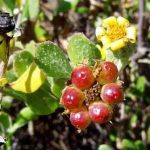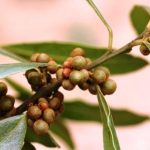TREE LIFE
December 2005
The Chairman and members of the Committee would like to wish all members and their families a very happy Christmas, and interesting walks in 2006.
MASHONALAND CALENDAR
Tuesday 6th December: Botanic Garden Walk. Meet Tom in the car park at 4.45 for 5 pm.
Sunday 11th December: Christmas social. Once again we are very lucky to have the use of the educational centre at the Botanic Gardens, Fifth Street for the whole day. All facilities are available and there will be no charge at the gate. We would like to thank the Head of the Herbarium and Botanic Garden Nozipo Nobanda for this generous gesture to the Tree Society.
After tea which will be served at 9.30 am, we will have a walk around the gardens.
Rob and Adele have compiled another general knowledge quiz. which will probably be before lunch depending on time. From the few dropped hints, this quiz will be slightly different from last year’s.
Please bring some Christmas fare to share for tea, and bring your own lunch, a wine glass and a chair. Terry Fallon has kindly offered to be on guard duty while we are walking in the garden.
Saturday 31st December: Mark’s walk is moved to New year’s Eve, and will take place at another of our favourite venues in the Arcturas area. Mr. Bill Clarke will again host this walk at Val d’Or. We will meet as usual at 2.30pm.
Tuesday 3rd January 2006 Botanic Garden Walk
MATABELELAND CALENDAR.
Please contact Jean Wiley or Gill Short for details of the next Matabeleland function.
CORKS AND CORK OAKS
In the Portuguese village of Marateca is a cork oak Quercus suber more than 200 years old. Its crown covers a fifth of an acre and three large men can barely circle its trunk. Every 9 years its main trunk and branches are stripped of their outer bark in lengths up to 8′ long and 2′ wide. It yields about a ton of bark which produces about 100 000 corks for wine bottles.
This is an exceptional tree. Cork oaks are farmed in vast planted forests in the south of Portugal and Spain. These forests are home to a variety of wild life which would be lost to us if the forests were changed to other trees or types of agriculture. Birds, pigs, wild boars, rabbits and other game live there. Side industries, aside from supporting cutters, growers and producers, are mushrooms, charcoal and firewood which add to the rural economies of much of southern Spain and Portugal.
It takes more than 40 years for a tree to produce really good quality cork and it is harvested every 9 years. From the cork are made bottle corks, tiles and charcoal as well as cork being used in about 100 industrial processes. Now an American company, Supreme Corq, has produced a synthetic ‘cork’ for the wine trade which is threatening the life of the cork forests and all associated with them.
The synthetic corks ensure no taint to the wine nor leakage. They do not have naturally occurring chemicals that can give the wine a bad taste but are not biodegradable either. Statistics on bad wine due to corkage vary as to which side is giving them. The cork industry says 1% or fewer bottles are “corked”, Tesco supermarkets say 5 to 8% and Australian winery Penfolds say 8 to 40%. So British supermarkets and Australian wineries are switching to corks and screw tops for some of their wines. Whilst this is a very small percentage of the world’s wine trade the success of the synthetic cork is enough to worry the owners of the cork forests as to their future viability.
-Adele Hamilton Ritchie
(after an article by John Vidal in The Guardian Thursday September 2, 1999)
DOMBOSHAWA’ SACRED FOREST: 9TH OCTOBER 2005
A hot day in October was the scene of one of our regular visits to Domboshawa. This outing continued the tradition of recent events by being quite poorly attended with only 7 members, but the group was full of fun and we had an interesting and enjoyable walk.
To make a change, instead of heading straight up the hill towards the col and the cave, we remained on the low ground and walked into the sacred forest at the base of the hill.
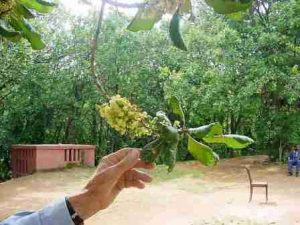
Uapaca kirkiana. Photo: Mark Hyde. Source: Flora of Zimbabwe
Rob Burrett explained that the sacred forest is called Rambakurimwa. It is also not really a forest but is actually woodland, heavily dominated by the mahobohobo (Uapaca kirkiana). It was also a very dry time of the year so we tended to scrunch noisily through the fallen mahobohobo leaves. Strangely, many of the male trees were in full flower. I remembered that the last time we saw flowering mahobohobos was in February. Coates Palgrave gives the flowering time as January to April, which fits in better with this – so October does seem to be a slightly anomalous time to be flowering.
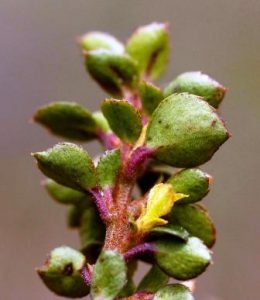
Myrsine africana. Photo: Bart Wursten. Source: Flora of Zimbabwe
In the woodland was the tiny species, Myrsine africana (the Small Myrsine). This is fairly common around Harare and in higher rainfall areas along the Central watershed towards the E Highlands but as it is quite inconspicuous it is readily overlooked. Viewed through a lens, the leaves have brown semi-translucent gland dots. Of the four species of this family, three have translucent glands or streaks in their leaves; the only one that does not is Maesa lanceolata. occurs down the eastern side of S Africa to the western Cape.
Also present was Lopholaena coriifolia, a composite, which often occurs in overgrazed places and in sandy poor soils. It has pale white heads which become fluffy and expanded in fruit. The leaves are greyish, smooth and slightly fleshy. Occasionally, this species has a woody base, but is not really big enough ever to qualify as a tree.
Having seen the thick-petalled flowers of the Granite garcinia or mangosteen (Garcinia buchananii) for the first time at Ruzawi on the previous month’s outing we saw them again here. There are 4 petals which are yellow and have an apical notch.
Our walk took us along near the base of the bare granite slopes of the mountain and there, with the Garcinia, were some other species typical of rocky places. One was a species of Elephantorrhiza, probably goetzei.
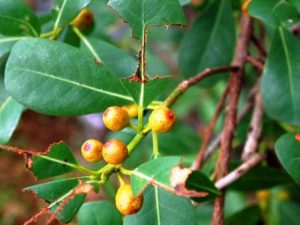
Ficus natalensis subsp. graniticola. Photo: Rob Burrett. Source: Flora of Zimbabwe
Another such plant was Ficus natalensis subsp. graniticola with its dark green leaves with truncate apex. This subspecies was recently described by John Burrows in his book Figs of Southern and South-Central Africa, a most impressive work which we hope to review in Tree Life in the future. This subspecies occurs on granite hills and amongst granite boulders; it is most widespread in Zimbabwe and it just reaches S Africa in the north (the Soutpansberg).
Two species of Tricalysia were also seen. This genus belongs to the family Rubiaceae and has the typical opposite leaves and interpetiolar stipules. One species was the fairly common Tricalysia niamniamensis (the Scaly-bark jackal-coffee) a small-leaved species which usually has domatia in the axils of the main veins beneath. The other was the much less common Tricalysia ruandensis (Mauve jackal-coffee) which has shiny dark green, hairless leaves. The latter is well known at Domboshawa where it grows quite close to the Interpretative Centre; this is a slightly different spot a bit further away.
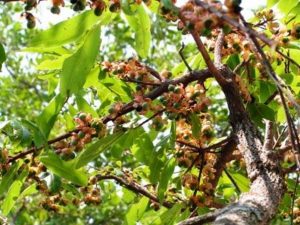
Ochna schweinfurthiana. Photo: Jos Stevens. Source: Flora of Zimbabwe
Also present on the rocks was Ochna schweinfurthiana (the Brick-red ochna). As we have seen before, flowers are rarely seen in ochnas, mostly because they are so short-lived, but the fruits are more frequently encountered. These often are green and are surrounded by red sepals, so that the whole structure is brightly coloured and quite striking. O. schweinfurthiana has a rough bark, breaking into square segments.
Both common beechwoods were seen, namely Faurea saligna and F. rochetiana. We finally made our way back to one of the covered areas near the Centre where we had a picnic and celebrated Richard Oulton’s birthday.
Energy levels were low after lunch, but some of us managed a short walk back into the Sacred Forest at a different point. There we found a large Ficus natalensis.
Although nothing very unusual was seen, it was a very pleasant (if rather hot) day.
-Mark Hyde
IN RETROSPECT – By Lyn Mullin
MUKUVISI WOODLAND MEMOS In TREE LIFE No.117 (November 1989) George Hall wrote:
I am honoured, Mr. Editor, that you should ask me to make a regular contribution to TREE LIFE. I have been studying the vegetation of the place since 1973. It is rare for me to go there, even now, and not find something new, or a variation on something old.
Familiar as I am with the Woodland, I remain very aware that I am still much of a “new boy”, relatively speaking, and, to act as an introduction to the Woodlands to readers less familiar with this delightful enclave of the wild kingdom, I have asked Mr. RW Petheram to write a few words of his recollections. Dick writes as follows:
Dear George,
Our brief chat the other day about the Mukuvisi Woodland stirred a few memories, stretching back a long way.
I have a vivid recollection of the excitement of a barbel chase when, in 1922 or ’23, the river flooded from a breach in the Cleveland Dam wall, and hordes of us kids, black and white, converged on foot and by bike on the Makabusi drift, not far from the present rail and road crossing on the way to Cranborne. At the time, Cleveland was the town’s only water supply – but that was something for our elders to worry about!
Years later, in the mid 1930s, the river again featured in a personal experience. Our bachelors’ mess had planned a move to new quarters on New Year’s Day, but a last-minute snag left us roofless. The mess boasted two rusty Model T Fords, so we piled our clobber into them, and headed for the Mukuvisi Woodland, where we camped under bits of canvas for a fairly rainy but amusing month. Presenting ourselves at office each day in the conventional, well-pressed, grey longs, white shirt, with tie and sports coat (only the seniors rose to the affluence of suits for everyday wear) was quite a challenge, but we usually managed to get there without msasa leaves in our hair, or waterberry stains on our collars. If there was, in those days, river pollution from any factory, we were unaware of it. The Woodland was delightful – not densely wooded, but appealing in its variety and its moods. These seemed dictated in part by the weather, and in part by communion with the river. Our intrusion was a peaceful one, and the occasional hare and duiker appeared to accept it as such. If we disturbed the bird life initially, it could not have been for long. They seemed to chatter an exchange of views about our early-morning showers from a rope tilting a four-gallon container in the trees, and to flit inquisitively in the late afternoon to see which of us was planning a night on the town.
These trivia are mentioned mainly as an admission that it simply did not occur to us, in those days, that there could be any threat to that relatively unspoilt little haven.
About thirty years later, though, in the late 1960s, Douglas Aylen brought us sorrowfully but firmly down to earth. He, Douglas, had retired from the staff of the Natural Resources Board, but, in a personal capacity, was still very active in the sphere of conservation and conservation planning. He was, among other things, a student of population pressures and modern living stress, and he could see more clearly than most of us the imperative for the preservation and, if possible, the expansion of open spaces.
In November 1968, after a great deal of preliminary work, he had at last aroused, in a wide cross-section of individuals and organizations, a sense of urgency in the matter, and he presented a 7?-page paper at a two-day national conference of the Rhodesia Council of Social Service. His `Makabusi Scheme’, as it was called, embraced the catchment area in general, and the Makabusi Woodland in particular. The scheme had already been endorsed by the NRB, the Association of Scientific Societies, the Natural Resources Society, and, of course, the Tree Society, of which Douglas was chairman; and it was unanimously supported at the conference. The specific references to the Woodland “close to this stretch of the River” described it as “some 600 acres of commonage, containing a wide variety of large trees, perhaps the sole remnant of tree-veld of this type”, and recommended that a large area of it “be preserved as a monument, a wild park, and for educational purposes”.
The cost of reproduction of this paper was enthusiastically borne by the Tree Society and the Natural Resources Society to ensure a wide distribution.
The scene now shifts to the 1970s. I made an attempt to record it in Science News in March 1979, which reads in part “The Natural Resources Society was prominent in continuing the campaign in 1971, and it became evident in January 1972, from the newly submitted Town Planning Scheme, that it was the municipal intention to carry out residential development in the Woodland area. A meeting at the University, under the auspices of the Natural Resources Society, resulted in a unanimous resolution objecting to the municipal proposals, and urging that the area be preserved for all time”.
“In the Pitman Report issued in May 1973 (Judge JB Pitman having been appointed by the Government to conduct an enquiry) the objections were upheld. It was evident from the report that this enlightened ruling could not be upheld indefinitely without clear evidence of continued positive interest in the Woodland, and it was not long before Mr R James, manager of the City Amenities Department, coined the phrase, “use it or lose it”.
The Woodland was, in fact, being used continuously by clubs, youth groups, schools, and individuals of all races, but the extent of its use was very little publicised. In keeping with the spirit of this theme, however, an advisory committee, Chaired by the Natural Resources Society, was formed in 1974, and served further to foster the concept of cooperative action among societies. In 1975 and 1976 the Wildlife Society turned its attention to the project, and produced a number of proposals for development. It convened a meeting of a large number of organizations, including the Municipality, and, as a direct result, first a liaison committee, and then a working group, took shape under the chairmanship of Mr. Rudyard Boulton; members came from the ranks of societies that had recently become affiliated to the newly formed Conservation Trust. From all this emerged, after a number of vicissitudes, a Makabusi Woodland Committee, with the following objectives:
- a) through the medium of the Conservation Trust, to attain a legal status as a non-profit company to negotiate a lease with the City.
- b) to draw up conservation and development plans.
c) to consider finance.
You and I, George, were both members of that committee. A lot of water has flowed down the river since that report was written, and many of our early, tentative plans have been amended, and some, no doubt, improved upon. As a subscribing member of the Makabusi Woodland Association, though not a very mobile one, I keep a little in touch with the events out there, and the activities of a number of clearly dedicated people, and, of course, the prominent influence of the Wildlife Society is not lost on anyone.
Reflecting on that, I must add that any emphasis on the Tree Society’s participation in the formative years of the Mukuvisi Woodland is not intended to denigrate the outstanding work of other societies, such as the Wildlife Society (of which, incidentally, I have been a member for a long time). The Ornithological Society’s most admirable activities also come prominently to mind. But it is an historical fact that, but for Douglas Aylen, there would probably be no woodland along the Mukuvisi any longer, and I think it is matter of pride that he pressed his case so ably and resolutely, largely from the Tree Society platform during his chairmanship, and also that we took up cudgels, you and I, from the same base in later years. With best wishes, etc.
Dick Petheram.
The foregoing is, I think, a very adequate introduction to our present interest in the Mukuvisi Woodland, illustrating the full Tree Society background. I am not one to dwell on the past; however, I believe, in this case, the historical background to this terribly vital conservation project in the heart of Harare is important.
[Comment 2000: George Hall continued to provide MUKUVISI WOODLAND NOTES for TREE LIFE for some time after the publication of Dick Petheram’s introductory background to the reservation of the Woodlands.]
FIBRES
Cotton fibres were gathered, spun and twisted at least 10,000 years ago in Peru.
Flax was woven and domesticated in the Near East at least 8000 years ago (at least 1000 years before the domestication of sheep).
Animal fibres such as wool have also been widely used. Flax replaced wool in Europe for clothing.
To a botanist, a fibre is an elongated cell with thick walls and tapering ends.
In commerce, fibres may be single cells or hundreds of cells. Fibres may vary from fractions of a mm to 2 meters in length.
Most plant fibres are comprised of cellulose. They are more stable to heat than are animal fibres. Plant fibres also have different properties when dyed and usually require more complex treatments to cause adherence of the dyes.
Many fibres are too slick, short or brittle to be spun into threads. Some fibres are used to make paper. Others, such as kapok, are too slick to spin into thread and are used to make stuffings or packing.
Fibres can be classified by their uses or the part of the plant they are from. Fibres are used for textiles, brushes, plaiting or coarse weaving, stuffing material, paper and specialty goods. Cotton, flax, ramie, and hemp are most often used for apparel or textile fibers. Jute, cotton, hemp, abaca, sisal, New Zealand flax, and Mauritius hemp are most often used for cordage. Istle, sisal, piassava (palm), and broomcorn (a Sorghum bicolor cultivar) are most often used for brushes or braiding fibres. Kapok, cotton, Spanish moss, and jute are most often used for filling fibres.
Textile fibres are primarily grouped into seed and fruit fibres; soft or bast fibres; and hard or leaf fibres. Bast fibres come from the phloem tissues of dicotyledonous plants. Hard fibres come from the leaves of certain mocotyledonous plants.
Fibre extraction
Bast fibres are removed from plant material by retting. The cell walls of soft, bast or true fibres are cellulose and are not easily broken down by bacteria. In retting, the plant material is placed in water or kept wet, while anaerobic bacteria digest away most of the plant tissue except the fibres.
The remaining material is bent sharply to break the remaining vascular material away from the true fibres. The material is then beaten and scraped (scutching) and the fibres combed to align them (hackling).
For hard fibres, the plant material is crushed and soft tissue scraped away. This process is called decorticating. Ginning is used to remove seed fibres from the seeds. The fibres are also combed and cleaned. Fibres may then be bleached or otherwise treated to prepare them for use.
Seed and fruit fibres
The most important seed fibre is cotton (Gossypium spp., Malvaceae). Cotton seeds have properties that permit them to be spun into thread. Kapok (Ceiba pentandra, Bombacaceae) cannot be used for this purpose and is used for stuffing. Coconut fruit fibres (coïr) are used for brushes and doormats.
Cotton is the most important fibre in the world today, and is, according to some sources, the most important nonfood plant commodity. Cotton production today is highly mechanized in most countries. This plant produces textiles that dye well and withstand vigorous washings.
Cotton is an epidermal hair of the seed coat. There are both short (linters) and long hairs. The short hairs are removed before the seeds are used for oil expression.
Cotton was domesticated in both the Old and New World (different species). The ancestry of cotton is complex and there is not complete agreement about these origins. Cotton was domesticated in south central Asia and fabrics from Pakistan appear about 3000 B.C. These were from either Gossypium arboreum or G. herbaceum. By the 15th century, cultivation of these two species had reached into Europe from the Arabs. Both have largely been replaced by New World cultivars.
Two species of cotton were also domesticated in the New World. Both may involve an Old World parent, although this is currently debated. Columbus observed cotton in the New World when he came to America. Gossypium hirsutum (upland or West Indian) cotton accounts for 95% of the cotton cultivated. G. barbadense, Sea Island, Egyptian, or Pima cotton was probably cultivated earlier and was used by about 8000 B.C. Weaving was an integral part of the culture in the Inca Empire in the 13th and 14th centuries.
Cotton did not become a major crop, however, until 1794 when Eli Whitney invented the cotton gin. Cotton then became the major crop in many areas of the Southeastern U.S. The cultivation of cotton was one of the major factors that led to slavery in the U.S. The invention of the cotton gin permitted cotton to be the basis of a one crop economy that was destroyed by the boll weevil about 1900. Since that time, agriculture has diversified greatly in the South.
Cotton boll
All cottons are perennials in nature, but an annual habit has been selected.
Cotton is usually defoliated before harvest today.
Cotton fibres are then processed extensively. The fibres are carded, and twisted into slivers. They are then drawn, cleaned (washed with caustic soda), mercerized (soaked with NaOH under pressure), and finally sized with substances such as starch or gels. After being woven, the fabrics are treated with ammonia to reduce shrinkage on washing.
Permanent press fabrics now decrease the need for ironing. The former USSR, China, USA, and India are major cotton producing countries. Cotton seed is widely used as an edible oil source. There are some problems with toxicity however.
Revised October 2003
(c) David S. Seigler, Plant Biology 263, Plants and Their Uses, Department of
Plant Biology, 265 Morrill Hall, 505 S. Goodwin Ave., University of Illinois,
Urbana, Illinois 61801, USA. 217-333-7577. seigler@life.uiuc.edu.
Wanted: articles for Tree Life …
TREE LIFE NEEDS YOU – or rather it needs your input. Articles, notes, comments, questions, observations – all are welcome.
Your contribution needn’t be long or weighty – a simple note or observation is often of great interest.
Don’t be put off by thinking you don’t know enough. Sit down and pen something today!
Mark Hyde
MARK HYDE CHAIRMAN


